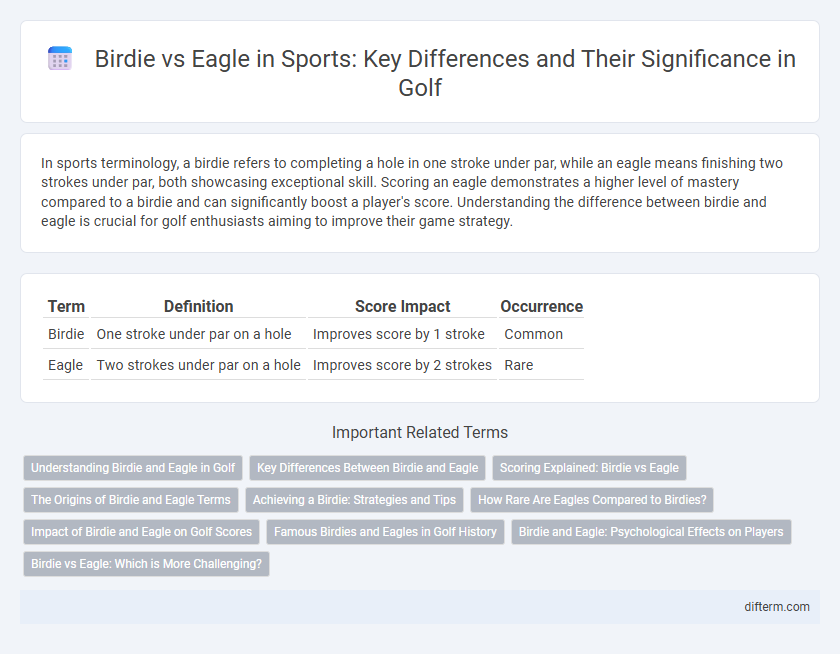In sports terminology, a birdie refers to completing a hole in one stroke under par, while an eagle means finishing two strokes under par, both showcasing exceptional skill. Scoring an eagle demonstrates a higher level of mastery compared to a birdie and can significantly boost a player's score. Understanding the difference between birdie and eagle is crucial for golf enthusiasts aiming to improve their game strategy.
Table of Comparison
| Term | Definition | Score Impact | Occurrence |
|---|---|---|---|
| Birdie | One stroke under par on a hole | Improves score by 1 stroke | Common |
| Eagle | Two strokes under par on a hole | Improves score by 2 strokes | Rare |
Understanding Birdie and Eagle in Golf
In golf, a birdie is a score of one stroke under par on a hole, typically three strokes on a par-4. An eagle is a more rare achievement, scoring two strokes under par, such as completing a par-5 hole in three strokes. Understanding the distinction between birdie and eagle helps players track performance and set competitive goals.
Key Differences Between Birdie and Eagle
A birdie in golf means completing a hole one stroke under par, while an eagle refers to finishing two strokes under par, making the eagle a rarer and more valuable score. Birdies typically occur more frequently than eagles due to the greater difficulty in achieving an eagle, often requiring a hole-in-one on a par 3 or reaching the green in two fewer strokes on longer holes. Understanding the key difference in strokes under par highlights the scoring impact and skill level associated with birdies versus eagles in competitive golf.
Scoring Explained: Birdie vs Eagle
A birdie in golf means completing a hole one stroke under par, while an eagle is two strokes under par, offering a more significant boost to a player's score. Birdies and eagles are key performance indicators, often influencing tournament leaderboards and player rankings. Achieving multiple birdies or eagles in a round can drastically lower a player's overall score, showcasing skill and precision.
The Origins of Birdie and Eagle Terms
The term "birdie" in golf originated in the United States around the early 20th century, stemming from the slang use of "bird" to mean something excellent or outstanding. The term "eagle" followed as a natural extension, representing a score even better than a birdie, symbolizing an impressive feat on the golf course. Both terms have since become integral to golf terminology, reflecting players' successes relative to par.
Achieving a Birdie: Strategies and Tips
Achieving a birdie in golf requires precise shot selection, focusing on accuracy and distance control to position the ball close to the hole in fewer strokes. Effective strategies include mastering approach shots, improving putting skills, and reading greens to enhance responsiveness. Consistent practice with course management and understanding hole layouts significantly increases birdie opportunities.
How Rare Are Eagles Compared to Birdies?
Eagles in golf occur significantly less frequently than birdies, with eagles appearing roughly once every 10,000 strokes compared to birdies appearing about once every 100 strokes. The rarity of eagles is due to the need to score two strokes under par on a hole, often requiring exceptional skill or advantageous conditions. Statistics from professional tours highlight that while birdies are a common achievement, eagles remain a standout performance that can dramatically influence a player's score.
Impact of Birdie and Eagle on Golf Scores
Birdie and eagle significantly influence golf scoring, with a birdie saving one stroke under par on a hole and an eagle saving two. Achieving a birdie can steadily improve a player's overall score, while an eagle often creates a substantial lead shift, especially in competitive play. Consistently making birdies and eagles differentiates elite golfers by lowering their total score and increasing their chances of winning tournaments.
Famous Birdies and Eagles in Golf History
Famous birdies in golf history include Tiger Woods' iconic 16th hole birdie at the 2005 Masters, showcasing his skill under pressure. Notable eagles feature Jack Nicklaus' stunning eagle on the 17th hole during the 1986 Masters, a pivotal moment in his career. These legendary scores reflect the high level of precision and strategy that define professional golf excellence.
Birdie and Eagle: Psychological Effects on Players
Birdie and eagle scores in golf significantly impact players' psychological states by boosting confidence and reducing performance anxiety. Achieving a birdie often reinforces positive momentum, enhancing focus for subsequent holes, while an eagle can elevate a player's morale and create a sense of accomplishment that sustains competitive drive. These scoring milestones serve as mental catalysts, influencing decision-making and resilience under pressure during tournaments.
Birdie vs Eagle: Which is More Challenging?
In golf, a birdie scores one stroke under par while an eagle scores two under par, making an eagle inherently more challenging due to the increased difficulty of completing the hole in fewer strokes. Achieving an eagle often requires exceptional skill and favorable conditions, such as precise long shots or reaching the green in fewer strokes than typical. Birdies, though still commendable, are more common and achievable by amateur players, whereas eagles are rarer and showcase advanced proficiency and strategic play.
birdie vs eagle Infographic

 difterm.com
difterm.com